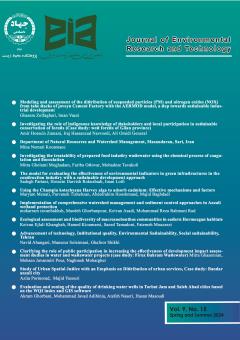The model for evaluating the effectiveness of environmental indicators in green infrastructures in the construction industry with a sustainable development approach
Subject Areas : پایداری محیطی
Sadegh Partani
1
![]() ,
Hossein Darvish Roknabadi
2
,
Iman Lotfi
3
,
Hossein Darvish Roknabadi
2
,
Iman Lotfi
3
![]()
1 - Assistant Professor, Department of Civil Engineering, University of Bojnord, Bojnord, Iran
2 - Senior expert in civil engineering and construction management, The expert in charge of the construction plans office of the Basic Knowledge Research Institute
3 - MSc student, Department of Civil Engineering, University of Bojnord, Bojnord, Iran
Keywords: Environmental Impacts, Green infrastructure, Construction, Urban development, Sustainable developmen,
Abstract :
The purpose of this research is to design a model for evaluating the impact of environmental indicators on green infrastructure in the construction industry with a sustainable development approach. In terms of method, the current research is descriptive- analytical, and the method of collecting data is field and survey. The data collection tools were questionnaires and interviews, and a seven-point Likert scale was used to design the questionnaire. A total of 50 people have been selected based on their full knowledge of the subject and work experience of three years or more, of which 30 people have actively and effectively participated and answered the questionnaires completely. Among these 30 people, male gender with 77%, master's degree with 57% and related work experience of 6 to 10 years with 50% have the highest relative frequency. The statistical population of the research is academic professors and experts and engineers of environment, green space, urban design and urban planning of Tehran city, which was selected by using electric bullet technique. SPSS software was used to analyze quantitative data and Cronbach's alpha was used to check the reliability and in the inferential statistics segment, the Analytic Network Process (ANP) network analysis process has been used in order to rank the relationships between the effective criteria on the evaluation of environmental indicators in green infrastructures in the construction industry with a sustainable development approach. The effective criteria obtained from expert opinions include 12 items, namely the Australian National Built Environment Assessment System (H), Building Research Environmental Assessment Method (A), Comprehensive Assessment System to Create Environmental Efficiency (F), High Quality Environmental Standard (G), Building Environmental Assessment Method(D), Green Star(E), Leadership in Energy Design(B), Building and Construction Administration(J), Green World(C), German Sustainable Building License(L) Green rating for integrated habitat evaluation (I) and three stars (K). The research results showed that "Australia's National Built Environment Assessment System (H)" has the highest rating with a final weight of 0.19028 and "Three Stars (K)" with a final weight of 0.009240 has the lowest rating determined from the factors related to the components affecting the evaluation of environmental indicators in green infrastructures in the construction industry with a sustainable development approach.
